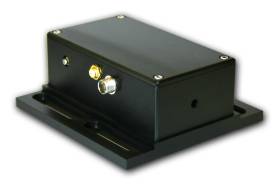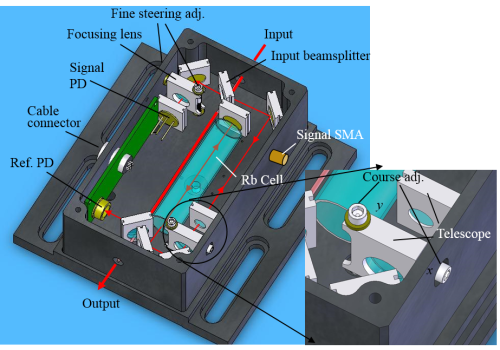Table of Contents
Spectroscopy Module (Obsolete)
Model No. D2-110
Document Revision: 1
Document Last Updated on 2021/08/26 14:26
Please read Limited Warranty and General Warnings and Cautions prior to operating the D2-110.
Description
Replaced by D2-210 Spectroscopy Module
The spectroscopy module provides saturated absorption spectroscopy to atomic rubidium. It contains a rubidium absorption cell, TEC, balanced photodetector, and associated mirrors and beamsplitting optics. Nominally, it takes two 1% samples from the input beam. Temperature control stabilizes the number density of atoms in the cell, and a balanced photodetection circuit compensates for intensity drifts giving stable control over the lock point for side locking applications. Two beamsteering adjustments are provided for optimizing overlap of the counter-propagating beams, and positioning on the signal photodiode. The photodiode output is shot-noise limited out to ~12 MHz for photocurrents of 50 A and above. The high bandwidth of the feedback enables tight solid locking that is immune to vibrations and shock.
Note: The spectroscopy module should not be placed closer than 3“ from the Laser module because the magnetic fields from the isolator can interfere with the hyperfine transitions causing lock instability and dc shifts.
Absolute Maximum Ratings
Note: All modules designed to be operated in laboratory environment
| Parameter | Rating |
| Environmental Temperature | >15°C and <30°C |
| Environmental Humidity | <60% |
| Environmental Dew Points | <15°C |
Specifications
| Value | Units | |
|---|---|---|
| Photodiode Amplifier | ||
| <html> </html> Transimpedance (signal) | 20,000 | Ω |
| <html> </html>Bandwidth (signal) | 12 | MHz |
| <html> </html>Noise @ 10 MHz <html> </html>(shot level) | 80 | nV / <HTML> √Hz</HTML> |
| Set Temperature | ~35 | °C |
| Temperature Stability | ~0.01 | °C |
| Beam Height | 0.95 | inches |
| Total package Size (L x W x H) | 4.25 x 4 x 2 | inches |
Inputs, Outputs, and Controls
Input Connector (8-pin circular)
Power and temperature control signals from the Laser Servo are made through an 8-pin circular connector. The pin definitions (pin numbers are marked on the connectors) are listed below, where Rth and Rth_Rtn are the two ends of the thermistor.
| Pin | Signal |
|---|---|
| 1 | TEC+ |
| 2 | TEC- |
| 3 | +15 V |
| 4 | Rth_Rtn |
| 5 | Rth |
| 6 | -15 |
| 7 | NC |
| 8 | GND |
Signal Output (SMA)
To minimize electro-magnetic interference, the photodiode signal to the Laser Servo is output through an SMA connector.
Course vertical and horizontal beam positioning
The spectroscopy module contains a 3x Galilean beam expander. The output lens is mounted on a spring-loaded mount with 2-56 screws that serve as a course adjustment for the beam positioning onto the signal photodiode and also to control the retro reflection of the reflecting mirror (figure 1).
Fine vertical and horizontal beam positioning
The spectroscopy module contains a focusing lens for the signal photodiode on a spring-loaded mount with 2-56 screws for fine adjustment of the beam onto the photodiode (figure 1).
Aligning the Spectroscopy Module
The spectroscopy module is shipped factory aligned and should need only minor adjustment. However, it is not uncommon that alignment is required after initial set up. To realign, follow this procedure:
- Fashion two small 1 cm x 3 cm cards from an index card for use as viewing screens.
- Remove the cover on the Spectroscopy Module.
- Following the instructions in section DBR Laser Module, adjust laser steering so the beam is centered onto the 6 mm diverging lens. Use the card for reference. This is the most critical alignment.
- At this point the beam should be going through the center of the input and output apertures on the module, the center of the 6 mm lens, and the second pick off should be impinging on the reference photodiode (see figure 1). Make adjustments as necessary.
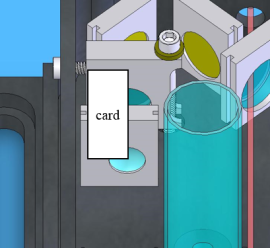
- Use the card to ascertain the position of the returned beam on the first corner mirror.
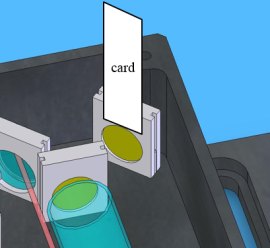
- Use the course positioning controls to place the retro-reflected beam as close as possible to the incoming beam.
- Use the card to probe the opposite corner mirror (along short side) to see if the retro beam is now passing back through the input beamsplitter.
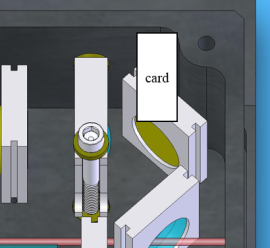
- If the beam is visible on the card, center it with the course positioning controls. If not, repeat from Step 6.
- Check to see that the beam is relatively well centered on the retro reflecting mirror at the end of the Rb cell. If not, the beam is not centered well enough on the 6 mm divergent lens. Start again from Step 3.
- Fold the second card lengthwise (light goes through a single layer) and block the reference photodiode while monitoring the SMA OUTPUT on an oscilloscope or voltmeter.
- Use the Course and fine steering controls to maximize the signal (actual signal is negative) on the voltmeter. Generally, the fine steering controls have little effect. You might find them useful if you wish to use the course controls to center the beam on the retro mirror and find this moves the beam off center from the signal diode.
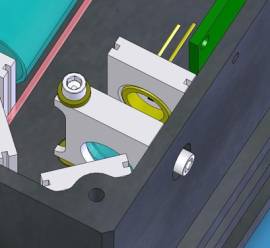
- Remove the card from the reference photodiode.
- Adjust the trimpot until a desired lockpoint for sidelocking crosses zero volts (with oscilloscope connected to the ERROR INPUT monitor, or until an eyeball average of the hyperfine transitions lies near zero volts. This step determines how well the balancing circuit cancels intensity drifts. (Note: for peak locking applications this is not important since dc drifts have no affect on the lockpoint.)
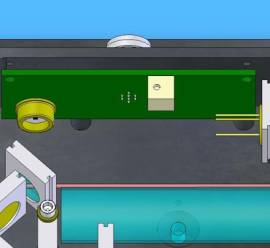
- The spectroscopy module is now ready for use. Replace the cover.

